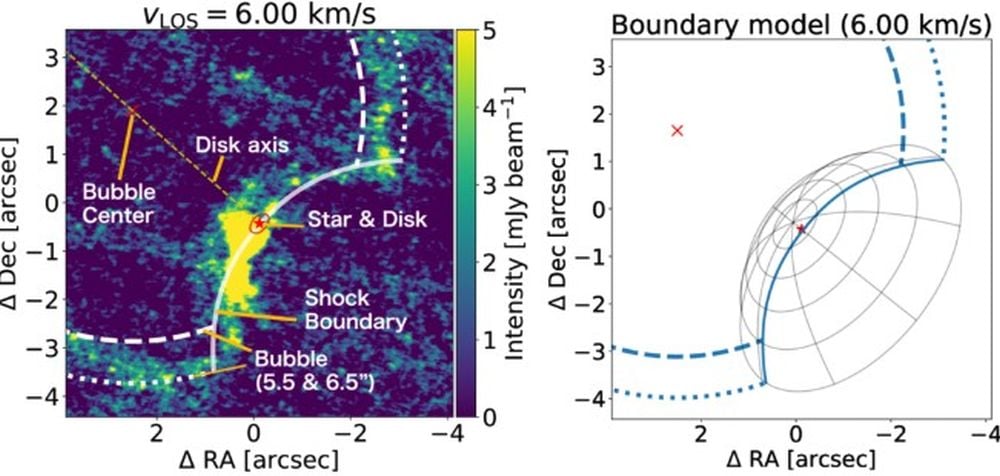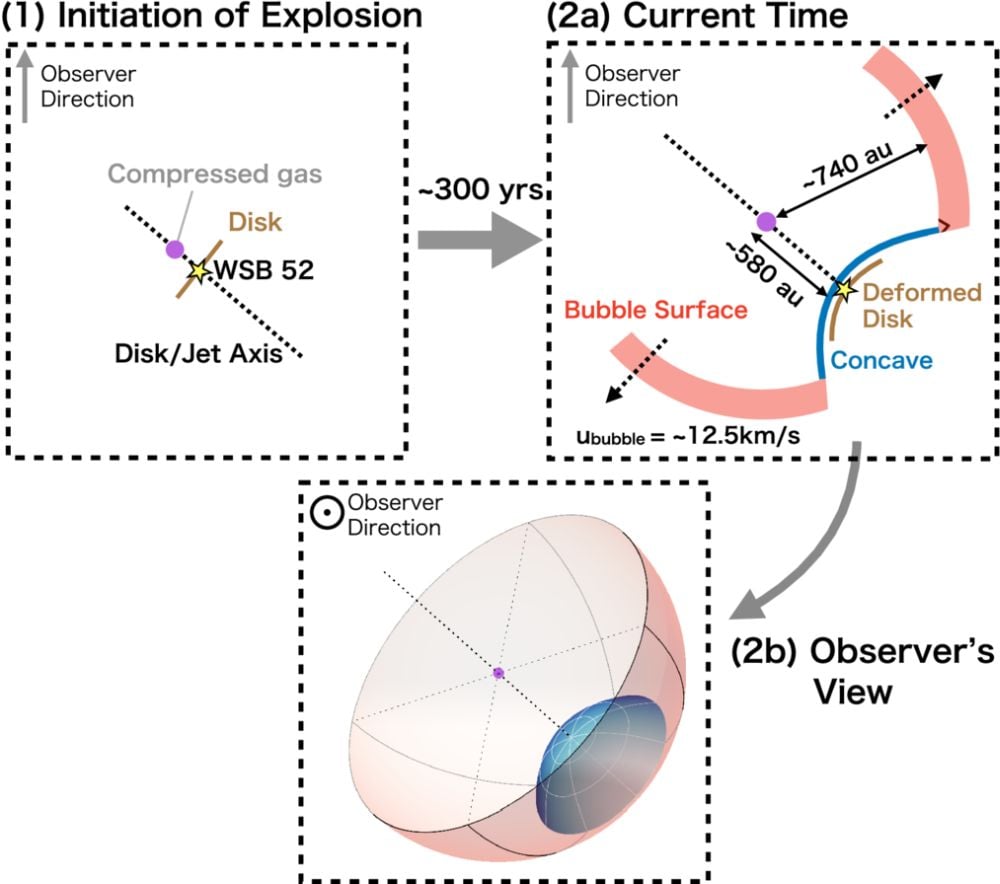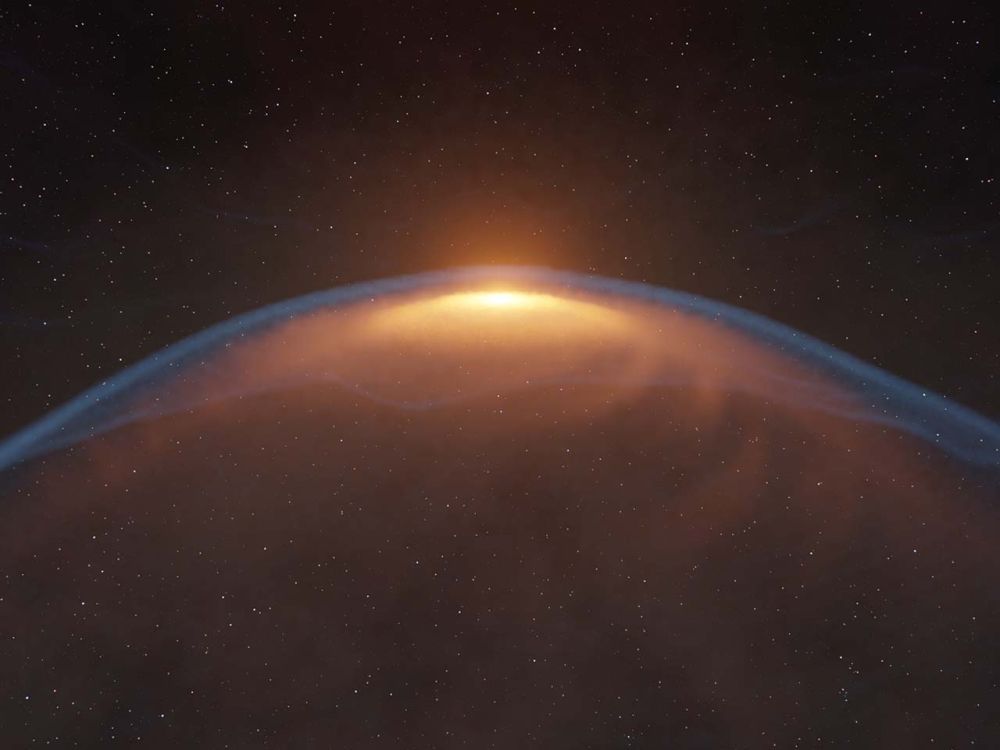Young stars are known for their instability and unpredictability. Their brightness can vary dramatically, they have stronger and more chaotic magnetic fields, and they can produce powerful stellar winds and jets. All of these fade as a star ages and becomes more placid.
Astronomers are keen to understand how their jets shape their surroundings. Among other effects, these explosive jets can carve out cavities or bubbles in the surrounding medium that can be several light-years across. Japanese astronomers found one young star's jets carving out a bubble that's backfiring and slamming into the star's protoplanetary disk. This is the first time this has been observed.
The discovery is in new research in The Astrophysical Journal titled "Discovery of Jet–Bubble–Disk Interaction: Jet Feedback on a Protoplanetary Disk Via an Expanding Bubble in WSB 52." The lead author is Masataka Aizawa. Aizawa is from the College of Science at Ibaraki University in Japan.
WSB 52 is a young stellar object (YSO) about 440 light-years away. Like other young stars, this one has a protoplanetary disk of gas and dust around itself out of which planets form. The young star accretes material from the disk as it grows, but not all of the material becomes part of the star. Some is emitted back into the surroundings from bi-polar jets that carve bubbles in the surrounding medium. Aizawa and his colleagues were working with archival data from the Atacama Large Millimeter/submillimeter Array (ALMA) and studying protoplanetary disks when they discovered something unusual about WSB 52. In the young star's case, the bubble is interacting with the planet-forming disk.
“ALMA’s high spectroscopic capabilities have unveiled the cross-section of an expanding bubble structure, as if it was examined with a CT scan,” said co-author Ryuta Orihara from the University of Tokyo. ALMA revealed a shock front from the expanding bubble that was slamming into the disk, distorting it and blowing away some of the gas.
"We identify an expanding bubble that interacts with its protoplanetary disk," the authors write in their research. "Given that the disk axis points toward the bubble’s center and the kinetic energy of the bubble is roughly 10^41 erg, we postulate that stellar jets, aligned with the disk axis, have triggered the bubble."
 *This figure from the research shows a close-up view of the shock boundary between the bubble and the star. The spatial morphology of the shock boundary is presented in the right panel. Image Credit: Aizawa et al. 2025. ApJ*
*This figure from the research shows a close-up view of the shock boundary between the bubble and the star. The spatial morphology of the shock boundary is presented in the right panel. Image Credit: Aizawa et al. 2025. ApJ*
Previous researchers have proposed that bubbles form when jets compress nearby cold gas that was emitted from the star during prior outbursts. The interaction creates an expanding bubble of hot gas. The unusual thing about WSB 52's bubble is its expansion velocity. The bubble's radial expansion velocity exceeds its velocity relative to the star, allowing the bubble to expand back into the disk.
As it collides with the disk, the disk then feeds into the jets again.
"The compressed hot gas exerts high pressure, leading to a spherical expansion that sweeps up interstellar material, manifesting as a shell," the authors explain. "We postulate that similar jet-driven mechanisms are responsible for the observed expanding bubble in WSB 52." The researchers are calling it a jet-bubble-disk interaction.
 *This schematic illustrates what the researchers think is happening at the young stellar object WSB 52. The first panel shows the system prior to the bubble's explosion about 300 years ago. The second panel shows the current state of the system, with the protoplanetary disk being deformed by the expanding bubble. The lower panel presents the observed view. Image Credit: Aizawa et al. 2025. ApJ*
*This schematic illustrates what the researchers think is happening at the young stellar object WSB 52. The first panel shows the system prior to the bubble's explosion about 300 years ago. The second panel shows the current state of the system, with the protoplanetary disk being deformed by the expanding bubble. The lower panel presents the observed view. Image Credit: Aizawa et al. 2025. ApJ*
However, the fact that no bubbles like this have been detected around other YSOs means the origins are uncertain. "We therefore caution that the origin of the bubble in WSB 52 remains uncertain and warrants further investigation," the researchers explain. "Nonetheless, this paper focuses on the outcome of the bubble’s interaction with the disk rather than its formation mechanism, and its conclusions do not depend on any specific assumption regarding the bubble’s origin."
These ALMA observations are based on 12CO emission lines, and the authors say that further observations of other carbon isotopes and different chemical species will help them understand the chemical composition of the gas in the bubble. It's possible that the chemistry of the gas was altered by the bubble interaction. "Furthermore, detailed dynamical modeling of the disk’s deformation caused by bubble wind will be important for understanding the bubble’s effect on the disk," the researchers write in their conclusion.
The researchers only found one example of this type of interaction among the DSHARP sample they studied. This suggests that these interactions are rare. "However, estimating the occurrence rates of bubbles is challenging due to the uncertain frequency of jet-interacting cold material," the authors write. "To better understand the prevalence and impact of these bubbles, more extensive surveys for similar explosive events are highly recommended."
“In science fiction, there are scenes where a beam is fired at something to destroy it, causing an explosion with debris flying back at the shooter," lead author Aizawa said in a press release. "Similar things occur in real astronomical phenomena, but with greater intensity. Through this discovery, I once again realized that nature is far more complex than humans think. In future research, I hope to further explore the effects of the explosions on the formation of stars and planetary systems.”
 Universe Today
Universe Today
